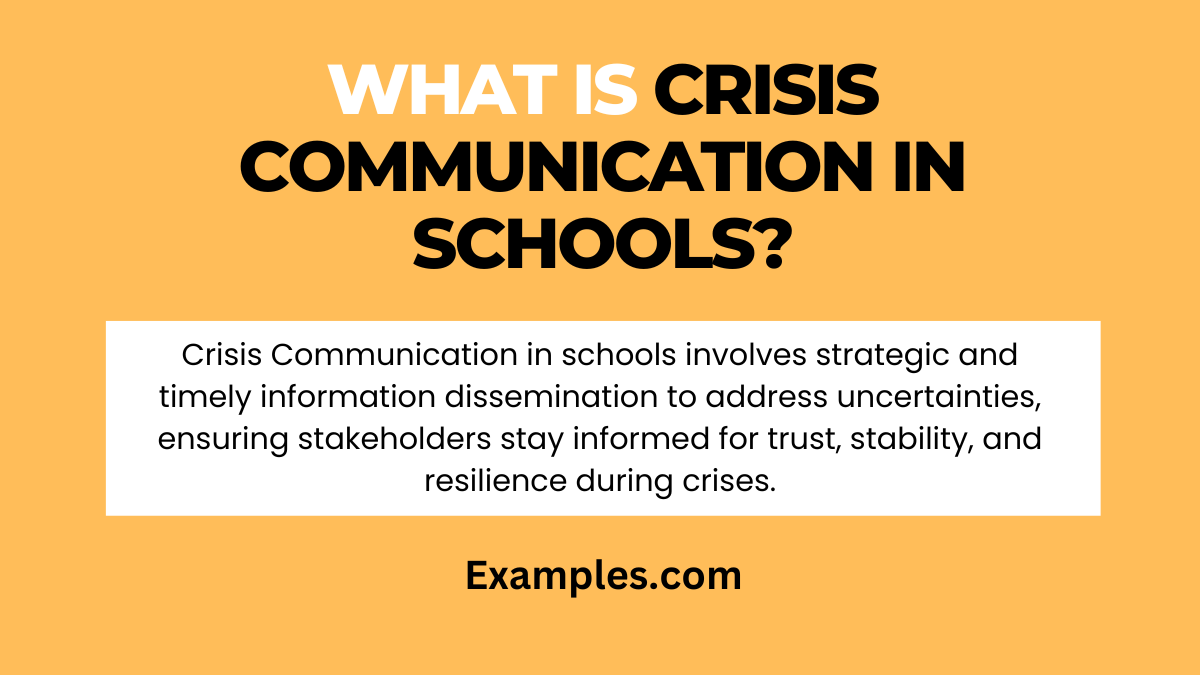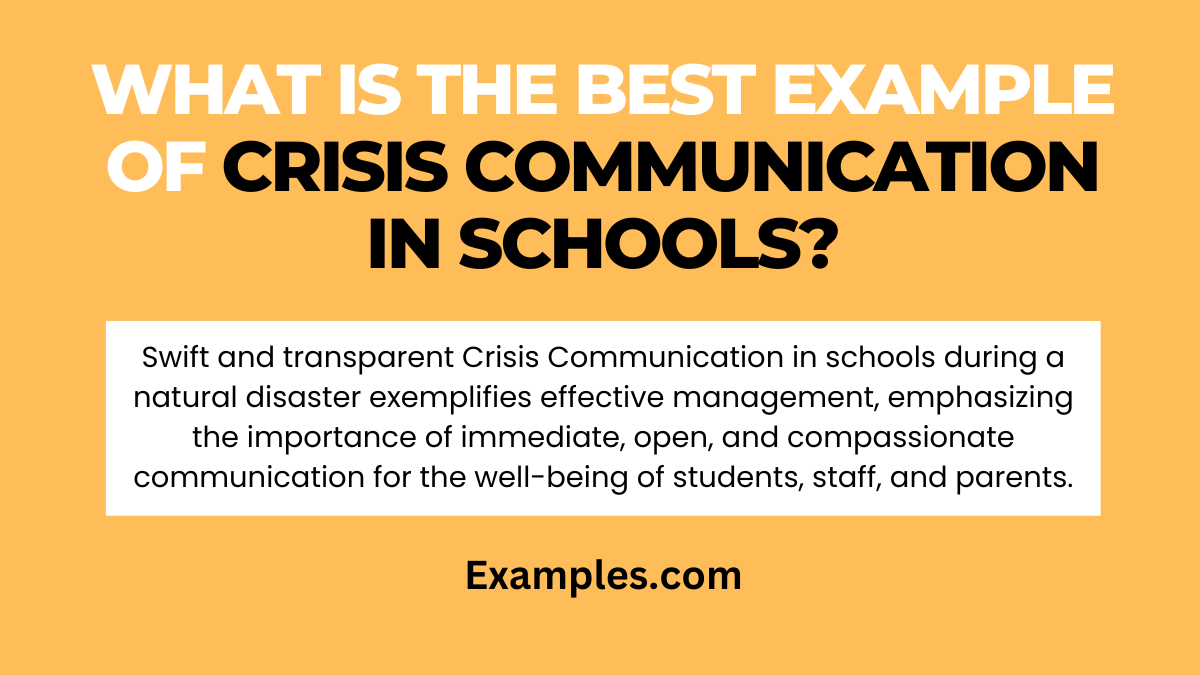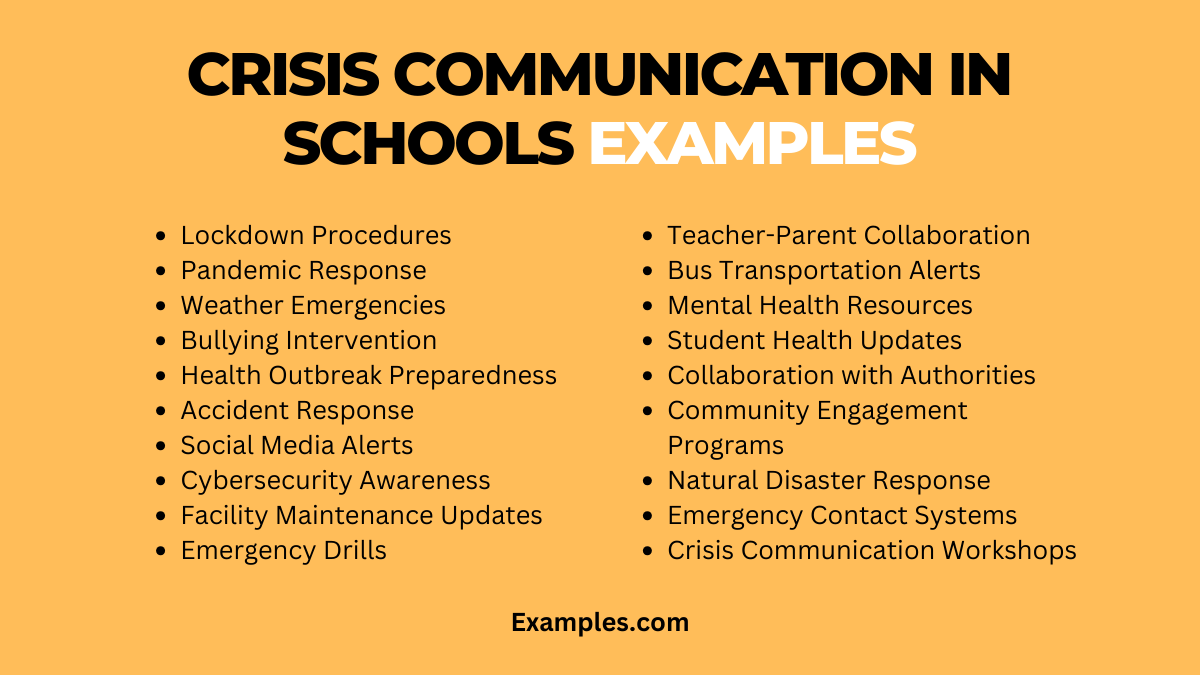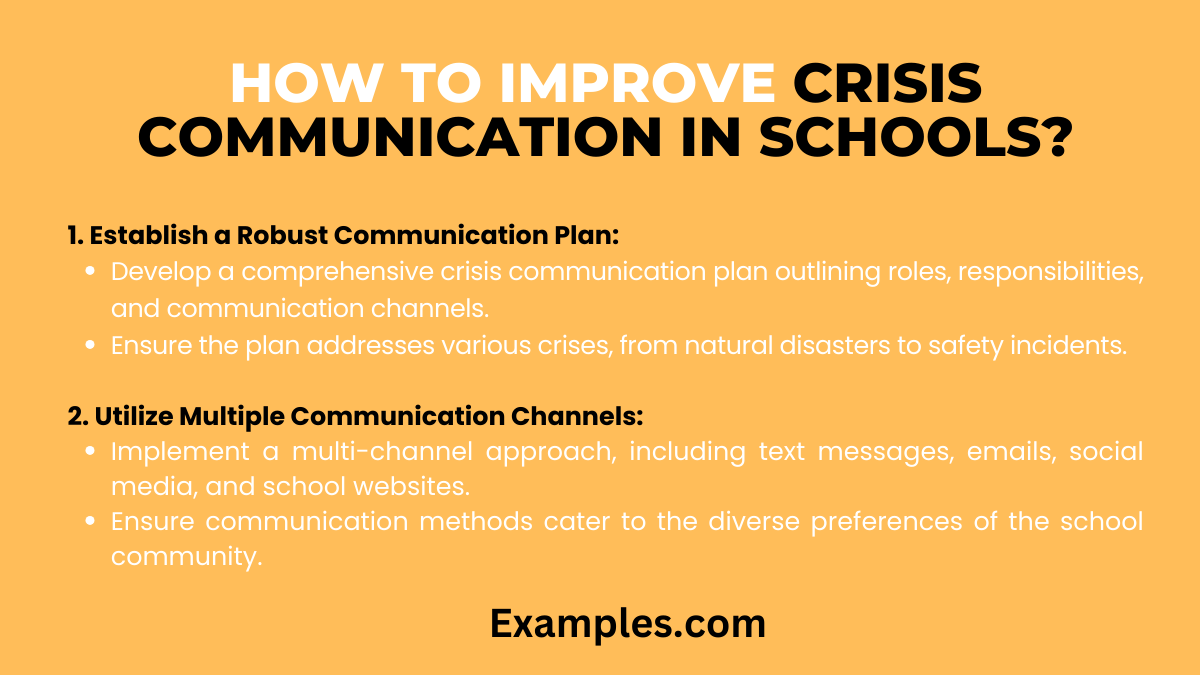19+ Crisis Communication in Schools Examples
Embark on a comprehensive exploration of Crisis Communication in Schools, where we dissect real-life scenarios in our detailed guide. Navigate through impactful Communication Examples, offering insights into effective strategies and tips. From crisis preparedness to maintaining trust, our guide ensures a robust understanding of Crisis Communication tailored specifically for educational institutions.
What is Crisis Communication in Schools?

Crisis Communication in schools is the strategic and timely dissemination of information during unexpected events or challenges. In simpler terms, it involves clear and prompt communication to address uncertainties, ensuring stakeholders stay informed. This proactive approach is vital for maintaining trust, stability, and a resilient school environment during crises.
What is the Best Example of Crisis Communication in Schools?

One exemplary instance of Crisis Communication in schools is the response to a natural disaster affecting a school community. Swift and transparent communication, providing safety updates, mobilizing resources, and addressing concerns, showcases effective crisis management. This scenario underscores the significance of immediate, open, and compassionate communication in navigating challenges and ensuring the well-being of students, staff, and parents during a crisis.
20 Crisis Communication in Schools Examples

Navigate through our curated list of 20 impactful instances showcasing effective Crisis Communication in educational settings. From natural disasters to student incidents, each example reflects proactive strategies, emphasizing transparency and trust-building. Learn from these real-world scenarios to enhance your school’s preparedness, ensuring a resilient and well-informed community during challenging times.
- Lockdown Procedures: Clear and concise communication during security threats assures parents and keeps students calm with well-practiced lockdown procedures.
- Pandemic Response: Swiftly adopting remote learning and communicating health measures demonstrates a school’s proactive response to a global health crisis.
- Weather Emergencies: Timely updates on school closures and safety measures during severe weather conditions showcase effective communication, ensuring the well-being of students and staff.
- Bullying Intervention: Addressing bullying incidents promptly and openly, coupled with counseling resources, fosters a safe and supportive school environment.
- Health Outbreak Preparedness: Detailed communication plans for potential health outbreaks ensure parents and staff are well-informed, minimizing panic and promoting community health.
- Accident Response: Transparent communication following accidents assures parents of safety measures in place and provides necessary support for affected students.
- Social Media Alerts: Utilizing social media for quick alerts during emergencies helps disseminate information rapidly to parents and the community.
- Cybersecurity Awareness: Communicating cybersecurity protocols educates students, parents, and staff on safeguarding sensitive information and online safety.
- Facility Maintenance Updates: Regular communication on facility maintenance ensures a safe and conducive learning environment, addressing concerns proactively.
- Emergency Drills: Informative drills and communication on emergency protocols prepare students and staff, instilling confidence in crisis preparedness.
- Teacher-Parent Collaboration: Transparent communication on students’ progress and challenges fosters a collaborative relationship, addressing concerns before they escalate.
- Bus Transportation Alerts: Timely communication on bus delays or route changes keeps parents informed and reassures them of their child’s safety during transportation.
- Mental Health Resources: Offering mental health resources and counseling information demonstrates a commitment to addressing students’ emotional well-being.
- Student Health Updates: Regular updates on health measures and vaccination requirements ensure a healthy school environment and keep parents well-informed.
- Collaboration with Authorities: Effective collaboration with local authorities and law enforcement ensures a coordinated response to potential threats, enhancing overall safety.
- Community Engagement Programs: Initiating programs that engage the community in crisis preparedness fosters a sense of shared responsibility and resilience.
- Natural Disaster Response: Communicating evacuation plans and safety measures during natural disasters assures parents and students of their well-being.
- Emergency Contact Systems: Utilizing multiple communication channels for emergency contacts ensures the dissemination of critical information to parents promptly.
- Crisis Communication Workshops: Conducting workshops for staff on crisis communication strategies enhances preparedness and ensures a cohesive response.
- Inclusive Communication: Ensuring communication is accessible to all, including non-English speakers and those with disabilities, promotes inclusivity and community support during crises.
Crisis Communication in Schools for Students Examples
In times of crisis, effective communication in schools is paramount. Empowering students with vital information ensures a resilient and well-informed community. Here are examples highlighting diverse crisis communication strategies:
- Emergency Evacuation Plans: Clearly communicate and practice emergency evacuation plans to ensure student safety. Example: “Boldly follow evacuation routes during fire drills for a secure school environment.”
- Mental Health Resources Awareness: Promote awareness of available mental health resources to support students’ emotional well-being. Example: “Discover bold resources for mental health – our counseling services are here to help.”
- Cyberbullying Prevention Campaigns: Launch campaigns addressing cyberbullying to create a safer online environment. Example: “Stand up against cyberbullying with bold actions – report any incidents to protect our digital community.”
- Interactive Virtual Learning Tools: Communicate the use of interactive virtual learning tools to facilitate engaging remote education. Example: “Boldly explore our virtual classroom – interactive tools make learning from home exciting.”
- Inclusive Extracurricular Activities: Ensure clear communication about inclusive extracurricular activities, promoting student participation. Example: “Join our bold inclusive club – discover a space where everyone’s talents shine.”
Crisis Communication in Schools for Teachers Examples
In times of crisis, effective communication is vital for teachers to navigate challenges and ensure a secure learning environment. Here are examples of how teachers can communicate during crises:
- Emergency Protocol Updates: Timely communication on updates to emergency protocols ensures teachers are well-informed to handle unforeseen situations. Example: “Boldly stay informed with our emergency protocol updates – your preparedness matters.”
- Digital Learning Support: Clear communication about digital learning resources aids teachers in adapting to online education methods. Example: “Access bold support for digital learning – our resources enhance your online teaching experience.”
- Mental Health Check-ins: Regular communication to check on teachers’ mental health fosters a supportive school community. Example: “Boldly prioritize well-being – our mental health check-ins create a caring teacher community.”
- Professional Development Alerts: Effective communication about professional development opportunities helps teachers enhance their skills. Example: “Stay bold in your growth – receive alerts about our professional development opportunities for educators.”
- Parent Collaboration Updates: Transparent communication on collaboration with parents strengthens the teacher-parent partnership. Example: “Boldly connect with parents for student success – our updates ensure a collaborative approach to learning.”
What is the Importance of Crisis Communication in Schools?
Crisis communication in schools holds paramount significance in maintaining a safe and supportive learning environment. Here’s a concise guide outlining its importance:
- Student Safety Assurance: Immediate communication assures parents and stakeholders of the school’s commitment to students’ safety during unforeseen events.
- Community Trust Building: Transparent communication fosters trust within the school community, demonstrating accountability and reliability.
- Rapid Information Dissemination: Efficient crisis communication ensures swift dissemination of crucial information, minimizing confusion and panic.
- Emergency Preparedness: Regular communication on safety protocols keeps all stakeholders informed and prepared for emergencies, enhancing overall school readiness.
- Parental Involvement Encouragement: In times of crisis, open communication encourages parental involvement and collaboration, reinforcing a unified approach.
- Staff Coordination and Support: Clear communication strategies aid in coordinating staff efforts and providing support during challenging situations, ensuring a cohesive response.
- Mental Health Acknowledgment: Communication that acknowledges the impact of crises on mental health promotes a compassionate and supportive school environment.
- Preventing Misinformation: By providing accurate and timely information, crisis communication helps prevent the spread of misinformation, maintaining the school’s reputation.
- Regaining Normalcy: Effective communication aids in the recovery process, helping the school community regain a sense of normalcy post-crisis.
- Continuous Improvement: Crisis communication allows for feedback and evaluation, facilitating continuous improvement in response strategies for future incidents.
How to Improve Crisis Communication in Schools?

Crisis communication in schools is essential for ensuring the safety, well-being, and informed decision-making of students, staff, and parents. Here’s a concise guide to enhance crisis communication:
- Establish a Robust Communication Plan:
- Develop a comprehensive crisis communication plan outlining roles, responsibilities, and communication channels.
- Ensure the plan addresses various crises, from natural disasters to safety incidents.
- Utilize Multiple Communication Channels:
- Implement a multi-channel approach, including text messages, emails, social media, and school websites.
- Ensure communication methods cater to the diverse preferences of the school community.
- Regular Training and Drills:
- Conduct regular training sessions and crisis drills for staff, emphasizing effective communication practices.
- Practice scenario-based exercises to enhance preparedness and responsiveness.
- Designate Communication Roles:
- Assign specific roles for communication within the crisis response team.
- Clearly define who communicates with the media, parents, staff, and students during different phases of a crisis.
- Transparent and Timely Updates:
- Prioritize transparency in communication, providing accurate and timely updates.
- Keep stakeholders informed about the situation, actions taken, and what to expect next.
Tips for Effective Crisis Communication in Schools?
Effective crisis communication in schools is paramount for ensuring the safety and well-being of students, staff, and the community. Here are concise tips to enhance crisis communication strategies:
- Establish a Communication Team:
- Designate key individuals responsible for communication during crises.
- Ensure the team is well-trained and familiar with various communication channels.
- Develop a Crisis Communication Plan:
- Create a comprehensive crisis communication plan outlining roles and responsibilities.
- Identify potential crises and establish protocols for each scenario.
- Utilize Multiple Communication Channels:
- Employ a variety of communication channels, including social media, email, and text alerts.
- Ensure information reaches diverse audiences through different platforms.
- Provide Timely Updates:
- Communicate promptly and regularly with stakeholders during a crisis.
- Offer frequent updates to keep the community informed of developments.
- Be Transparent and Honest:
- Foster trust by providing accurate and transparent information.
- Acknowledge challenges and address concerns openly.
In conclusion, effective crisis communication in schools is the bedrock of safety and community resilience. By implementing robust strategies, maintaining transparency, and prioritizing the well-being of students, staff, and parents, schools can navigate crises with confidence. A comprehensive guide, rich with examples, empowers educational institutions to create secure environments and build trust in the face of challenges.



